Hantian Ding
Horizon-Length Prediction: Advancing Fill-in-the-Middle Capabilities for Code Generation with Lookahead Planning
Oct 04, 2024Abstract:Fill-in-the-Middle (FIM) has become integral to code language models, enabling generation of missing code given both left and right contexts. However, the current FIM training paradigm, which reorders original training sequences and then performs regular next-token prediction (NTP), often leads to models struggling to generate content that aligns smoothly with the surrounding context. Crucially, while existing works rely on rule-based post-processing to circumvent this weakness, such methods are not practically usable in open-domain code completion tasks as they depend on restrictive, dataset-specific assumptions (e.g., generating the same number of lines as in the ground truth). Moreover, model performance on FIM tasks deteriorates significantly without these unrealistic assumptions. We hypothesize that NTP alone is insufficient for models to learn effective planning conditioned on the distant right context, a critical factor for successful code infilling. To overcome this, we propose Horizon-Length Prediction (HLP), a novel training objective that teaches models to predict the number of remaining middle tokens (i.e., horizon length) at each step. HLP advances FIM with lookahead planning, enabling models to inherently learn infilling boundaries for arbitrary left and right contexts without relying on dataset-specific post-processing. Our evaluation across different models and sizes shows that HLP significantly improves FIM performance by up to 24% relatively on diverse benchmarks, across file-level and repository-level, and without resorting to unrealistic post-processing methods. Furthermore, the enhanced planning capability gained through HLP boosts model performance on code reasoning. Importantly, HLP only incurs negligible training overhead and no additional inference cost, ensuring its practicality for real-world scenarios.
Learning Code Preference via Synthetic Evolution
Oct 04, 2024

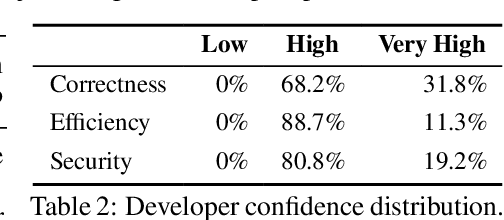
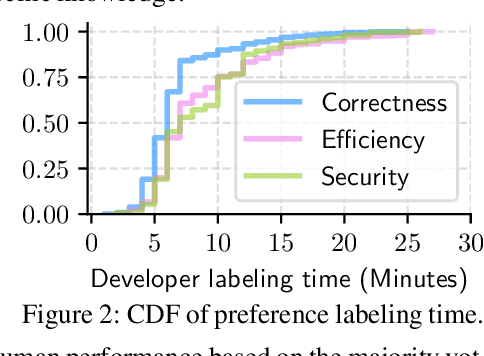
Abstract:Large Language Models (LLMs) have recently demonstrated remarkable coding capabilities. However, assessing code generation based on well-formed properties and aligning it with developer preferences remains challenging. In this paper, we explore two key questions under the new challenge of code preference learning: (i) How do we train models to predict meaningful preferences for code? and (ii) How do human and LLM preferences align with verifiable code properties and developer code tastes? To this end, we propose CodeFavor, a framework for training pairwise code preference models from synthetic evolution data, including code commits and code critiques. To evaluate code preferences, we introduce CodePrefBench, a benchmark comprising 1364 rigorously curated code preference tasks to cover three verifiable properties-correctness, efficiency, and security-along with human preference. Our evaluation shows that CodeFavor holistically improves the accuracy of model-based code preferences by up to 28.8%. Meanwhile, CodeFavor models can match the performance of models with 6-9x more parameters while being 34x more cost-effective. We also rigorously validate the design choices in CodeFavor via a comprehensive set of controlled experiments. Furthermore, we discover the prohibitive costs and limitations of human-based code preference: despite spending 23.4 person-minutes on each task, 15.1-40.3% of tasks remain unsolved. Compared to model-based preference, human preference tends to be more accurate under the objective of code correctness, while being sub-optimal for non-functional objectives.
Fewer Truncations Improve Language Modeling
Apr 16, 2024



Abstract:In large language model training, input documents are typically concatenated together and then split into sequences of equal length to avoid padding tokens. Despite its efficiency, the concatenation approach compromises data integrity -- it inevitably breaks many documents into incomplete pieces, leading to excessive truncations that hinder the model from learning to compose logically coherent and factually consistent content that is grounded on the complete context. To address the issue, we propose Best-fit Packing, a scalable and efficient method that packs documents into training sequences through length-aware combinatorial optimization. Our method completely eliminates unnecessary truncations while retaining the same training efficiency as concatenation. Empirical results from both text and code pre-training show that our method achieves superior performance (e.g., relatively +4.7% on reading comprehension; +16.8% in context following; and +9.2% on program synthesis), and reduces closed-domain hallucination effectively by up to 58.3%.
Bifurcated Attention for Single-Context Large-Batch Sampling
Mar 13, 2024Abstract:In our study, we present bifurcated attention, a method developed for language model inference in single-context batch sampling contexts. This approach aims to reduce redundant memory IO costs, a significant factor in latency for high batch sizes and long context lengths. Bifurcated attention achieves this by dividing the attention mechanism during incremental decoding into two distinct GEMM operations, focusing on the KV cache from prefill and the decoding process. This method ensures precise computation and maintains the usual computational load (FLOPs) of standard attention mechanisms, but with reduced memory IO. Bifurcated attention is also compatible with multi-query attention mechanism known for reduced memory IO for KV cache, further enabling higher batch size and context length. The resulting efficiency leads to lower latency, improving suitability for real-time applications, e.g., enabling massively-parallel answer generation without substantially increasing latency, enhancing performance when integrated with postprocessing techniques such as reranking.
Code Representation Learning At Scale
Feb 02, 2024

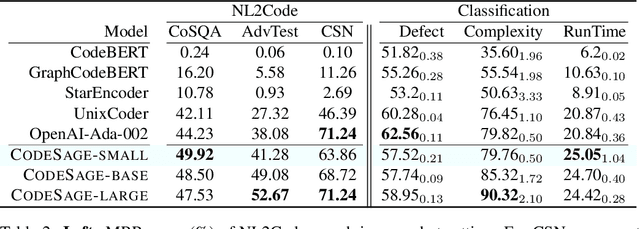

Abstract:Recent studies have shown that code language models at scale demonstrate significant performance gains on downstream tasks, i.e., code generation. However, most of the existing works on code representation learning train models at a hundred million parameter scale using very limited pretraining corpora. In this work, we fuel code representation learning with a vast amount of code data via a two-stage pretraining scheme. We first train the encoders via a mix that leverages both randomness in masking language modeling and the structure aspect of programming language. We then enhance the representations via contrastive learning with hard negative and hard positive constructed in an unsupervised manner. We establish an off-the-shelf encoder model that persistently outperforms the existing models on a wide variety of downstream tasks by large margins. To comprehend the factors contributing to successful code representation learning, we conduct detailed ablations and share our findings on (i) a customized and effective token-level denoising scheme for source code; (ii) the importance of hard negatives and hard positives; (iii) how the proposed bimodal contrastive learning boost the cross-lingual semantic search performance; and (iv) how the pretraining schemes decide the downstream task performance scales with the model size.
* 10 pages
CrossCodeEval: A Diverse and Multilingual Benchmark for Cross-File Code Completion
Oct 17, 2023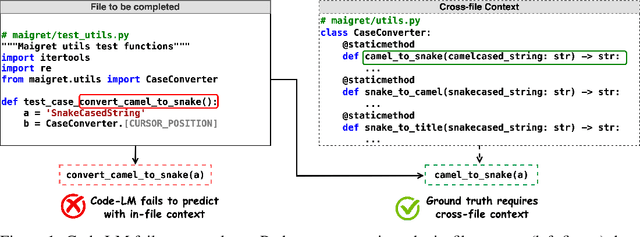
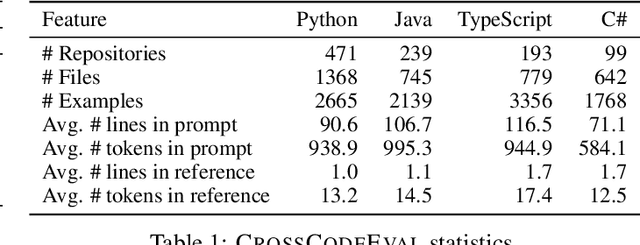
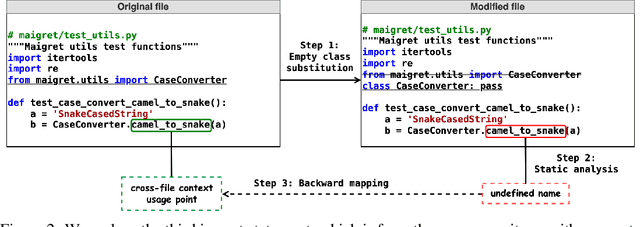
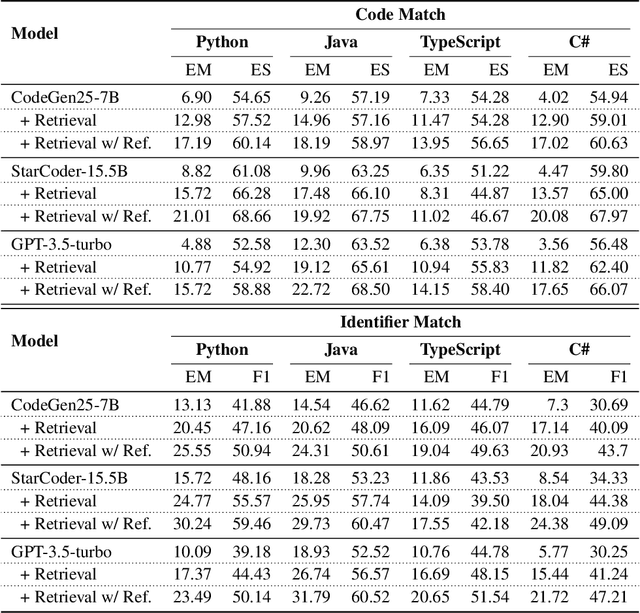
Abstract:Code completion models have made significant progress in recent years, yet current popular evaluation datasets, such as HumanEval and MBPP, predominantly focus on code completion tasks within a single file. This over-simplified setting falls short of representing the real-world software development scenario where repositories span multiple files with numerous cross-file dependencies, and accessing and understanding cross-file context is often required to complete the code correctly. To fill in this gap, we propose CrossCodeEval, a diverse and multilingual code completion benchmark that necessitates an in-depth cross-file contextual understanding to complete the code accurately. CrossCodeEval is built on a diverse set of real-world, open-sourced, permissively-licensed repositories in four popular programming languages: Python, Java, TypeScript, and C#. To create examples that strictly require cross-file context for accurate completion, we propose a straightforward yet efficient static-analysis-based approach to pinpoint the use of cross-file context within the current file. Extensive experiments on state-of-the-art code language models like CodeGen and StarCoder demonstrate that CrossCodeEval is extremely challenging when the relevant cross-file context is absent, and we see clear improvements when adding these context into the prompt. However, despite such improvements, the pinnacle of performance remains notably unattained even with the highest-performing model, indicating that CrossCodeEval is also capable of assessing model's capability in leveraging extensive context to make better code completion. Finally, we benchmarked various methods in retrieving cross-file context, and show that CrossCodeEval can also be used to measure the capability of code retrievers.
Exploring Continual Learning for Code Generation Models
Jul 05, 2023



Abstract:Large-scale code generation models such as Codex and CodeT5 have achieved impressive performance. However, libraries are upgraded or deprecated very frequently and re-training large-scale language models is computationally expensive. Therefore, Continual Learning (CL) is an important aspect that remains underexplored in the code domain. In this paper, we introduce a benchmark called CodeTask-CL that covers a wide range of tasks, including code generation, translation, summarization, and refinement, with different input and output programming languages. Next, on our CodeTask-CL benchmark, we compare popular CL techniques from NLP and Vision domains. We find that effective methods like Prompt Pooling (PP) suffer from catastrophic forgetting due to the unstable training of the prompt selection mechanism caused by stark distribution shifts in coding tasks. We address this issue with our proposed method, Prompt Pooling with Teacher Forcing (PP-TF), that stabilizes training by enforcing constraints on the prompt selection mechanism and leads to a 21.54% improvement over Prompt Pooling. Along with the benchmark, we establish a training pipeline that can be used for CL on code models, which we believe can motivate further development of CL methods for code models. Our code is available at https://github.com/amazon-science/codetaskcl-pptf
Towards Open-Domain Topic Classification
Jun 29, 2023



Abstract:We introduce an open-domain topic classification system that accepts user-defined taxonomy in real time. Users will be able to classify a text snippet with respect to any candidate labels they want, and get instant response from our web interface. To obtain such flexibility, we build the backend model in a zero-shot way. By training on a new dataset constructed from Wikipedia, our label-aware text classifier can effectively utilize implicit knowledge in the pretrained language model to handle labels it has never seen before. We evaluate our model across four datasets from various domains with different label sets. Experiments show that the model significantly improves over existing zero-shot baselines in open-domain scenarios, and performs competitively with weakly-supervised models trained on in-domain data.
A Static Evaluation of Code Completion by Large Language Models
Jun 05, 2023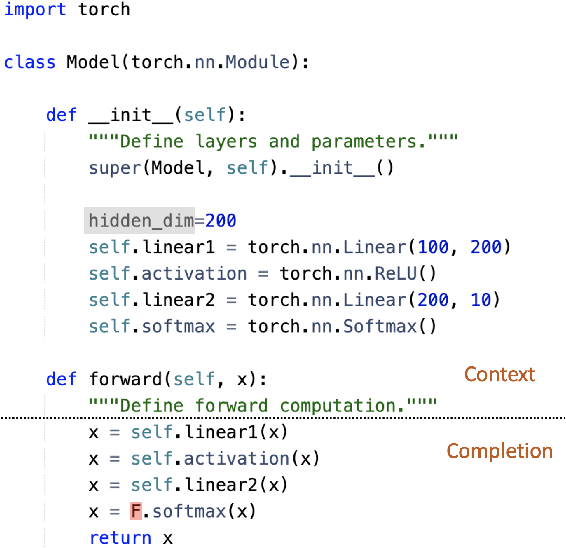
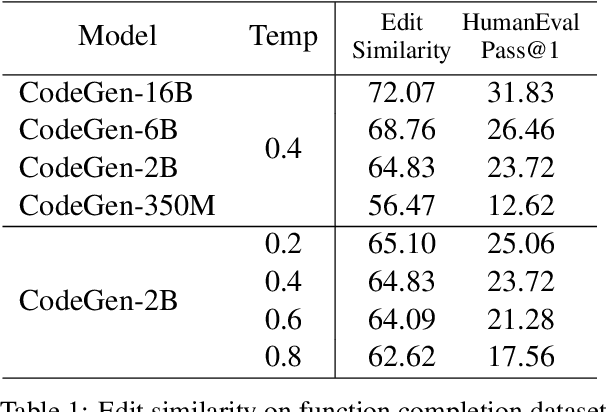
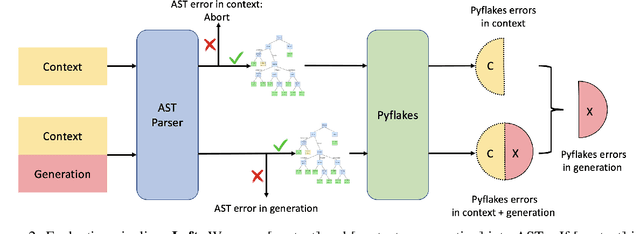
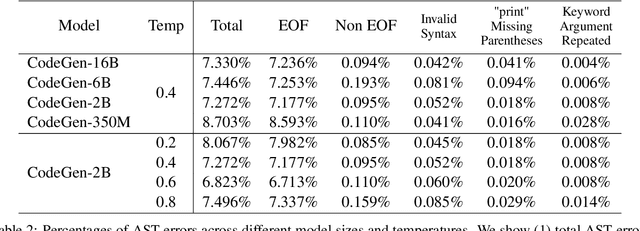
Abstract:Large language models trained on code have shown great potential to increase productivity of software developers. Several execution-based benchmarks have been proposed to evaluate functional correctness of model-generated code on simple programming problems. Nevertheless, it is expensive to perform the same evaluation on complex real-world projects considering the execution cost. On the contrary, static analysis tools such as linters, which can detect errors without running the program, haven't been well explored for evaluating code generation models. In this work, we propose a static evaluation framework to quantify static errors in Python code completions, by leveraging Abstract Syntax Trees. Compared with execution-based evaluation, our method is not only more efficient, but also applicable to code in the wild. For experiments, we collect code context from open source repos to generate one million function bodies using public models. Our static analysis reveals that Undefined Name and Unused Variable are the most common errors among others made by language models. Through extensive studies, we also show the impact of sampling temperature, model size, and context on static errors in code completions.
Multi-lingual Evaluation of Code Generation Models
Oct 26, 2022

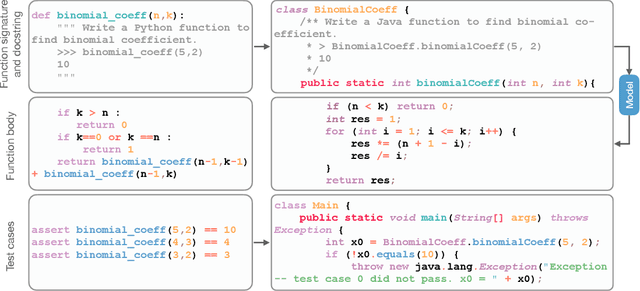

Abstract:We present MBXP, an execution-based code completion benchmark in 10+ programming languages. This collection of datasets is generated by our conversion framework that translates prompts and test cases from the original MBPP dataset to the corresponding data in a target language. Based on this benchmark, we are able to evaluate code generation models in a multi-lingual fashion, and in particular discover generalization ability of language models on out-of-domain languages, advantages of large multi-lingual models over mono-lingual, benefits of few-shot prompting, and zero-shot translation abilities. In addition, we use our code generation model to perform large-scale bootstrapping to obtain synthetic canonical solutions in several languages. These solutions can be used for other code-related evaluations such as insertion-based, summarization, or code translation tasks where we demonstrate results and release as part of our benchmark.
 Add to Chrome
Add to Chrome Add to Firefox
Add to Firefox Add to Edge
Add to Edge